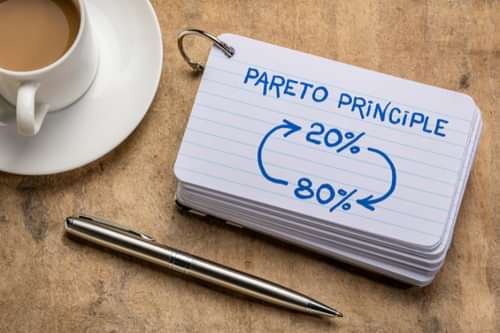
WATCH NOW: Unlock Growth with 80/20
"The best defense against the dangers of the comfort zone is to employ the 80/20 rule, which identifies how people squander time, effort and dollars doing things that previously worked or seem critical yet don’t deliver an adequate return." - Anthony Bahr in an op-ed featured in Forbes.

It feels emotionally secure to repeat rituals and stick to tried-and-true business practices, but the comfort zone presents dangers to future success. You miss opportunities when you don’t challenge your thinking. Worse, you repeat mistakes.
The best defense against the dangers of the comfort zone is to employ the 80/20 rule, which identifies how people squander time, effort and dollars doing things that previously worked or seem critical yet don’t deliver an adequate return. The concept, traceable to Italian economist Vilfredo Pareto, recognizes that 80% of your results come from 20% of your activities. Put in stark terms, 20% of what you do matters, the rest is a waste of time. The key to success is identifying the crucial 20% of input and prioritizing it.
The 80/20 principle permeates business: 20% of customers, and 20% of products, generate 80% of revenue. My firm has seen this play out hundreds of times. For example, when we analyze a company’s customer base, we routinely find the top 20% of customers are not only responsible for 80% of revenue, but the entire bottom half of the customer base often generates just 4% of revenue.
Profitability skews even more when businesses invest equal amounts of attention and dollars on all customers and operations, regardless of their earnings contributions. The result is the top 20% of customers often produce more than 150% of profits, according to our analysis. Everything else is a drain on resources.
If you’re going to spend time on something, spend it on what matters most.
That advice sounds simplistic, but running a business according to 80/20 principles means committing to a form of ruthless efficiency. It doesn’t mean doing more with less. It means doing less with less, which requires eliminating some product lines or businesses while prioritizing some customers or projects over others. Those are uncomfortable demands. The customer is king, you tell yourself. Well, no, not every customer.
1. 80/20 is not about cost-cutting, it’s about time management. Just lop off the bottom performers, right? No. The 80/20 philosophy is rooted in the idea of analyzing your business, identifying the best customers and prioritizing service to them so they stay with you. Yes, you’ll discard some customers and products, but you don’t necessarily reduce headcount or investment. You redeploy resources to focus on what matters.
Leaders fear this approach, because it appears short-sighted to lavish attention on big customers at the expense of cultivating the next big fish, but the reality is conversion rarely happens. When we ask clients to look back a decade and analyze their customer base, they invariably find the majority of their best customers didn’t start at the bottom as minnows. They were always whales.
2. It’s a culture, not a one-time exercise. It takes a long time for an organization, especially a sales-driven culture, to realize that not every sale is a good sale, and not every dollar coming in the door has the same value. An industrial supply firm offered more than 10,000 products to its sprawling customer base, even though the top quartile generated 95% of sales. The entire bottom half was worth just 1% of revenue. Those small customers were paying less than the big ones, a fact the client didn’t realize. Our recommendation was to raise prices on those customers and reduce the margin on the best customers to retain them. This increased revenue.
Companies adopting 80/20 will overhaul their sales and compensation structures, manufacturing, distribution, billing — everything to prioritize the most valuable relationships. That takes time but pays off.
3. You’re likely already doing 80/20, but under duress (and without a plan). Every management team has a sense that it can operate more efficiently, but most don’t have a set of principles to guide performance and enforce discipline. When times get tough, they make hard decisions on the fly. Coca-Cola finally eliminated Tab to streamline production during Covid. Airlines cut routes. There are plenty of examples of companies forced to simplify their businesses because of supply chain issues, but it’s purely reactionary. While many companies during Covid took revenue hits, many increased profits because they were forced to focus on the most valuable parts of their business. Imagine if they embraced that philosophy as an operating model.
4. When you go 80/20, emotions will intercede. Deal with them. Company owners love their early products, the ones that built their business. They are attached to legacy customers. Everyone’s got their favorites. (“We’ve had an office in Topeka for 20 years!”) But according to 80/20 principles, you follow the data and find the courage to do what’s right, or accept the financial consequences.
This is an especially tricky demand when it comes to customers. Despite the cutthroat nature of capitalism, many people in business have an egalitarian ethos that demands everyone should be treated the same and must have an amazing experience. That’s an unprofitable way to run a business, because you end up over-serving small customers and under-servicing your most valuable ones. One industry that does it right is airlines, which prioritize high-paying passengers, giving them elite status and better customer service. It’s not that everyone else is treated poorly. They still get to their destination safely. But they are treated differently, which is what many businesses struggle to accept.
The 80/20 model may make you squirm, because it forces you to confront the data that exposes your firm’s inefficiencies and misguided assumptions. It identifies wasted opportunities by putting a spotlight on what’s most important. The 80/20 rule doesn’t demand that you jettison most of what you do, but it opens your eyes to the possibilities of improved performance. More than anything, it highlights the consequences of running a company the same old comfortable way.
--
This article, "The 80/20 Rule is Brutal. That's Why It Works." was originally published in Forbes.

Profits
150%
Top 20% of customers often produce more than 150% of profits.

Anthony Bahr is Managing Director of Strategex’s Customer Due Diligence practice – a revolutionary practice area that’s disrupting private equity. He has worked with over 50 private equity firms on countless transactions to prevent deal failure.
Before joining Strategex, Anthony held senior-level positions at two leading market research firms where he specialized in insight, strategy, and innovation projects for global financial services, consumer packaged goods, and pharmaceutical clients.
A veteran of the United States Air Force, Anthony holds a B.B.A. in economics and international business from Loyola University Chicago as well as an M.S. in public policy from the University of Oklahoma.

WATCH NOW: Unlock Growth with 80/20

WATCH NOW: Unlock Growth with 80/20

Buy High, Sell Higher

Buy High, Sell Higher

Understanding the 80/20 Principle

Understanding the 80/20 Principle
Contact us to see how we can help your business today.
Never miss a beat. Get our latest insights in your inbox.